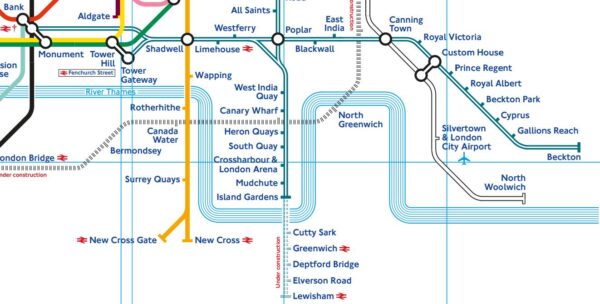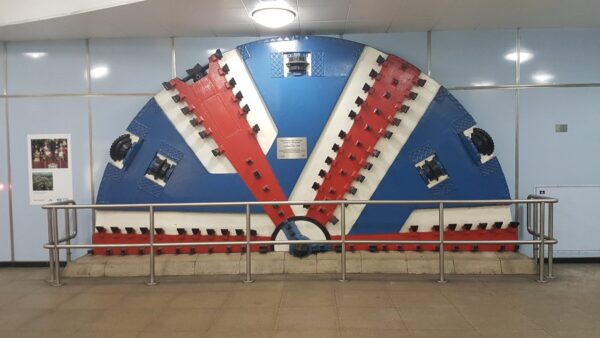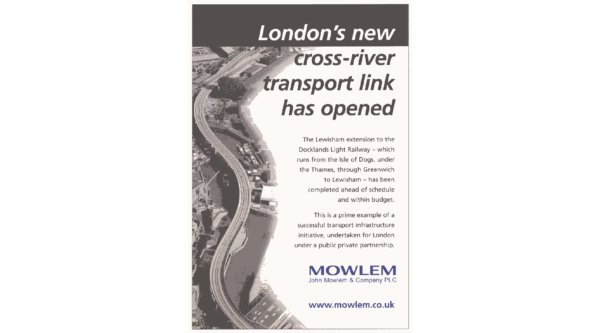It looks and operates like the rest of the DLR, but the tunnels and tracks between Island Gardens and Lewisham are owned by a private company.
But not from next week, when a 24½-year concession expires and TfL takes ownership.
How did part of the DLR end up being owned by a private company?
The origins of the Lewisham extension can be traced back to 1988, when London Transport and the London Docklands Development Corporation (LDDC) carried out a study of the public transport needs of the docklands area entitled “A Transport Strategy for Docklands”.
That recommended that a link is built to break the transport barrier of the River Thames which made travel to the growing Canary Wharf estate difficult for people living south of the river.
It took a couple of years for plans to be put in place, although the bill authorising the extension wasn’t debated until early 1992. The bill, as proposed at the time was contentious as the government wanted the LDDC to manage the Lewisham extension, although the LDDC was at the time dealing with lots of reliability problems on the DLR that it managed.
In the end, it was agreed to let Serco run the DLR as a franchise, which is how it has been run ever since.
The government also wanted the rail extension to be funded by a private company under a “build-operate-transfer” agreement, where the company builds the railway, operates it for a number of years and then hands it over to the government.
(Later the City Airport and Woolwich Arsenal extensions followed the same pattern, but were bought out in 2011)
Approval for a £100 million link in principle was given in 1993, with bids from private companies to build and operate it due the following year. Slightly optimistically, it was expected that the extension would be opening by 1997.
The contract was however not awarded until September 1996, and the cost had doubled to £200 million, and although the project was supposed to be privately financed, £50 million was to come from the government due to the capping of rail fares which reduced the economic viability of the extension.
The winner of the contract was a newly formed company, City Greenwich Lewisham Rail Link (CGL Rail), a consortium of John Mowlem, Hyder Investments, London Electricity and Mitsui and Co.
Contracts were signed in September 1996, and work started the following month with an expectation that it would open by January 2000.
The extension was due to replace the existing stations at Mudchute, Island Gardens, run under the Thames to the rebuilt station at Greenwich mainline, then add two new stations, Deptford Bridge and Elverson Road before terminating next to Lewisham mainline railway station.
Astute eyes may have noticed a missing station – Cutty Sark. That was not part of the original plans, and was only added after funding was agreed by demolishing the buildings at street level and using the new development to pay for the station.
The whole Cutty Sark project was controversial due to the size of land that needed to be redeveloped, and the entrance had been intended to be on the main road (where Waterstones is today), rather than down the crescent arcade where it ended up.
The first of the tunnels under the Thames was completed in October 1997 – and later part of the tunnel boring machine would be put on display inside Cutty Sark station.
The first trial trains ran on 10th March 1999, and the line was ceremonially opened on 22nd November by the then Deputy Prime Minister, John Prescott, just ahead of the Millenium, and two months earlier than the contractors were required to open it.
It opened to the public the following day and if you’re very rich, you could have a solid silver train ticket for the trip.
Initially, it was expected that passengers would have to pay a premium to use the link under the Thames, but John Prescott announced at the Labour Party Conference in 1999 that a grant of £20 million would be made to replace the toll. The DLR agreed to compensate CGL Rail accordingly.
“We have given the service an extra £20m to get new trains, and scrapped a toll proposal meaning cheaper fares, and more passengers attracted to public transport. People will save £1 per round trip.” Mr Prescott said at the opening event.
Since then, with little change, CGL Rail has been looking after the extension under its concession.
But that time is nearly up — the 24½-year long concession expires on 31st March 2021.
Ahead of the handover of the concession, a Handover Committee was set up with DLR in late 2017. Asset surveys started in March 2019 to ensure that when the concession ends, that the railway has been maintained to the required standards.
TfL has confirmed that the concession is ending as planned and that all the assets built by CGL Rail will transfer to TfL, while the DLR’s current franchise operator, Keolis Amey Docklands will take over the maintenance of the railway. The transfer of the extension from private hands to TfL will also reduce the cost of running the railway as it fits into the DLR’s wider maintenance programmes.
A TfL spokesperson also confirmed that the 32 staff who currently work on the extension will have their jobs protected as they transfer (TUPE) from CGL Rail to Keolis Amey Docklands.
So, at midnight on Wednesday 31st March, TfL gets a little bit bigger as it takes ownership of the Lewisham extension, 25 years after the first contracts were signed.










I guess I can thank DPM Prescot for being able to travel from Stratford International to Greenwich and Lewisham for £1.50 in 2021.
I really looking forward to the day the PSAs can stop pretending to be train drivers and go back to being nice to people (and checking Oysters) on the DLR trains.
Agreed, though as they are people like the rest of us you’ll always get the odd one that will always be right.
I remember one time many years ago, travelling from Stratford to Bow Church, I can’t remember why I needed to buy a ticket on the DLR platform, I would have been coming from the Central Line and probably had a travel card to zone 3 only, anyway the machine wasn’t working and I approached the PSA, needlessly as tickets weren’t being checked, to buy a ticket on the train as it was possible back then and I was thrown off at Pudding Lane. Nice reward for being honest.
Out of 36 years of regular travelling, a total of 3 incidents with only 2 being on TfL services does show how efficient and professional the vast majority of the employees are.
TfL take over one of the Thames ferry crossing business. Woolwich? TfL takes over DLR. But, but, private companies do public transport so much more efficiently and cheaper than the government. Could conservative politicians possibly be wrong?
Considering how many of the Labour government initiated PPP deals proved vastly more expensive than expected, if you are going to engage in petty politics, get the facts right first.
Private money does indeed make more things possible, but it comes at a price, look at the PFI initiatives.
Unfortunately there’s more involved than meets the eye, but where possible, using public finances to provide public services and infrastructure and keeping it in the hands of the public is always going to work out better than keeping shareholders happy in my opinion.
“TfL take over one of the Thames ferry crossing business. Woolwich?”
A contract with a private provider to operate a public service – the Woolwich Ferry – ended and TFL made other arrangements to run the ferry. No take over of a private business took place.
“TfL takes over DLR”
A franchise agreement to build & maintain an asset ended and TFL decided to make other arrangement in line with the provisions of the original contract. Again no private assets were taken over. The private company likely did very well out of the concession they had.
Mudchute is included in this not just from Island Gardens to Lewisham
Terrific article about something I’m sure a vast amount of rail fans like me had no idea about.